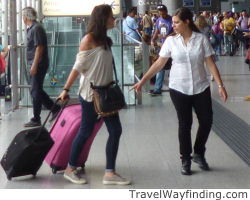Improving Travel for People
with Mobility Issues
Ways to Make Travel for People with Mobility Issues
More Accessible, Practical and Enjoyable
City and transportation planners, architects, travel companies and others who influence the design of travel signage, tactile pavements, and access in buildings and outside structures directly impact the travel experience for people who use wheelchairs and walking aids.
According to wayfinding expert Paul Symonds of TravelWayfinding.com, "Everyone has a right to travel and this has been documented in legislation in many countries including the U.S., UK and with EU laws." Symonds offers the following practical solutions to improve travel for people with mobility issues.
Indoor Mapping Technology
Getting lost can be bad enough when traveling. But, getting lost when having to help someone or yourself move using a wheelchair or other mobility aid makes the situation even more difficult.
The introduction of technologies, including indoor mapping, now means that finding facilities and locations, including those specifically needed and used for accessible travel can more easily be found.
For example, digital maps and directions to a "special assistance" desk, baggage claim, or a check-in area in a given facility make traveling more manageable and less concerning for people with and without disabilities.
While indoor mapping still has a long way to go, it will ultimately provide benefits to people mobility issues.
Audio App Technology
Symonds notes that people with hearing and vision problems are sometimes forgotten by those who design wayfinding and navigation systems for travel locations. The good news is that mobile phone apps are beginning to fill the void and to aid these travelers.

Beacons are a technology being used for indoor mapping. They provide a means for programmers to develop audio guidance through earpieces that can assist those with hearing and sight challenges. As a result, these individuals will benefit from greater independence when traveling for business and leisure.
Awareness and Understanding
The problems faced by those with mobility constraints can often be easily reduced and improved. A lack of planning and consideration for all users is often at the forefront of many accessibility issues.
Consider the difficulty of viewing signage from a distance while sitting in a wheelchair when your view is blocked by other travelers in front of you. All vantage points should be considered when placing signage in public places and tourist areas. The good news is that awareness is growing and greater understanding is increasingly being considered in wayfinding studies.
Related Articles - Travel for People with Mobility Issues
Disabled Friendly Travel Resources
Finding the Right Wheelchair Accessible Hotel
Accessible Camping
Wheelchair RV Vacationing
Selecting an Accessible-Friendly Hotel
Hotline for Air Travelers with Disabilities
Tips on ADA Hotel Selection
Making Accessible Travel Reservations Online
Popular ArticlesTypes of Mobility Chairs Wheelchair Sports Activities Helpful Resource Organizations Mobility Scooter Buying Tips Portable Ramp Options |


